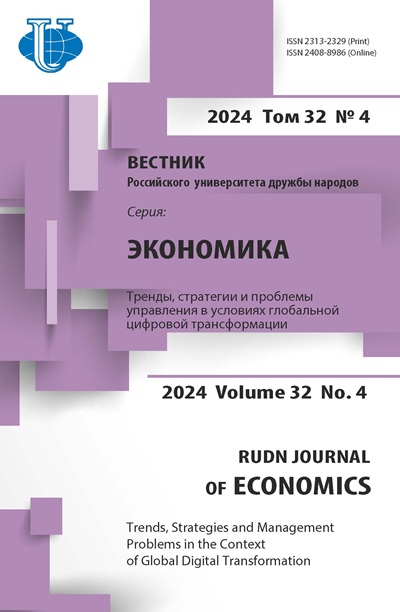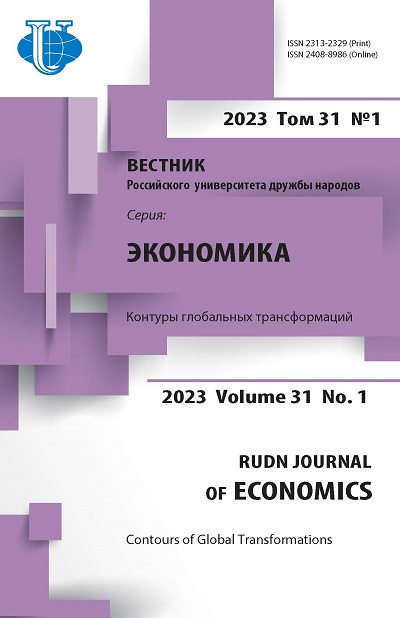Transforming interpretations of food security
- Authors: Yakimovich E.A.1,2
-
Affiliations:
- Peoples’ Friendship University of Russia
- LLC «GEH Teploenergoremont»
- Issue: Vol 31, No 1 (2023): CONTOURS OF GLOBAL TRANSFORMATIONS
- Pages: 91-106
- Section: Industrial organization markets
- URL: https://journals.rudn.ru/economics/article/view/34245
- DOI: https://doi.org/10.22363/2313-2329-2023-31-1-91-106
- EDN: https://elibrary.ru/RDVMCN
Cite item
Full Text
Abstract
The research shows the change in the concept of food security from the Malthusian approach to its modern interpretation, based on four aspects of food security - availability, access, use and stability. It is shown that the growing problems with all forms of food security in the world are due not only to the growing number of conflicts, extreme weather events and economic shocks, but also to the increasing spread of inequality, which reduces the chances of achieving food security in the long term. It is substantiated that the four-component approach to the interpretation of food security does not cover the entire range of aspects that are important for its provision. The concept of freedom of action for food security, or the concept of food sovereignty, which emphasizes the right of peoples to determine their own food systems to secure their own livelihoods and access to culturally acceptable food, is a necessary condition for food security. It is concluded that the inclusion in the concept of a wider number of aspects, including subjectivity, such as independence in decision-making regarding one’s own food security or food sovereignty and sustainability of food security in the long term will contribute to rethinking current strategies and practices in the field of food security.
About the authors
Elena A. Yakimovich
Peoples’ Friendship University of Russia; LLC «GEH Teploenergoremont»
Author for correspondence.
Email: isupoval@mail.ru
Candidate of Science (in Economics), an Аssistant of the International Economic Relations Department, Faculty of Economics, Peoples Friendship University of Russia, Deputy General Director for Economics and Finance of LLC «GEH Teploenergoremont». 6 Miklukho-Maklaya St, Moscow, 117198, Russian Federation; 43, bldg. 3, Khersonskaya St, Moscow, 117246, Russian Federation
References
- Abbade, E. (2016). Availability, access and utilization: Identifying the main fragilities for promoting food security in developing countries. World Journal of Science, Technology and Sustainable Development, 14(4), 322-335. https://doi.org/10.1108/WJSTSD-05-2016-0033
- Barraclough, S.L., & Utting, P. (1987). Food security trends and prospects in Latin America. Working Paper, USA: Helen Kellog Institute for International Studies, University of Notre Dame, 99.
- Béné, C., Fanzo, J., Prager, S.D., Achicanoy, H.A., & Mapes, B.R. (2020). Global drivers of food system (un)sustainability: A multi-country correlation analysis. PloS ONE, 15(4).
- Béné, C., Oosterveer, P., Lamotte, L., Brouwer, I.D., & Haan, S. (2019). When food systems meet sustainability - current narratives and implications for actions. World Development, 113, 16-30.
- Bickel, G., Nord, M., Price, С., Hamilton, W., & Cook, J. (2000). Guide to Measuring Household Food Security, Revised 2000. U.S. Department of Agriculture, Food and Nutrition Service, Alexandria VA. March.
- Burchi, F., & De Muro, P. (2016). From food availability to nutritional capabilities: Advancing food security analysis. Food Policy, 60, 10-19.
- Carlsson, L., Callaghan, E., Morley, A., & Broman, G. (2017). Food system sustainability across scales: a proposed local-to-global approach to community planning and assessment. Sustainability, 9(6), 1061.
- Chappell, M.J. (2018) Beginning to End Hunger: Food and the Environment in Belo Horizonte, Brazil, and Beyond. Oakland, USA: University of California Press.
- Cole, M., Augustin, M.A., Robertson, M., & Manners, J. (2018). The science of food security. Science of Food, 2. https://doi.org/10.1038/s41538-018-0021-9.
- Devereux, S. (2001) Sen’s Entitlement Approach: Critiques and Counter-critiques. Oxford Development Studies, 29(3), 245-263.
- El, Bilali, H., Callenius, C., Strassner, C., & Probst, L. (2018). Food and nutrition security and sustainability transitions in food systems. Food and Energy Security, 8(2), 1-20.
- Hamad, H., & Khashroum, А. (2016). Household Food Insecurity (HFIS): Definitions, Measurements, Socio-Demographic and Economic Aspects. Journal of Natural Sciences Research, 6(2), 63-75.
- Herforth, A., & Ahmed, S. (2015). The food environment, its effects on dietary consumption, and potential for measurement within agriculture-nutrition interventions. Food Security, (7), 505-520. https://doi.org/10.1007/s12571-015-0455-8
- Hwalla, N., Labban, S.E., & Bahn, R.A. (2016) Nutrition security is an integral component of food security. Front Life Science, 9(3), 167-172.
- Jaworska, M. (2018). Food Imports and Food Security of Main Global Market Players. Economic Sciences for Agribusiness and Rural Economy, (2). https://doi.org/10.22630/esare.2018.2.32
- Malthus, T.R. (1798). An essay on the Principles of Population or a view of its past and present effects on human happiness with an inquiry into our prospects respecting the future removal or mitigation of the evils which it occasions. London: printed for J. Johnson, in St. Paul’s Church - Yard, 134. Retrieved from http://www.esp.org/books/malthus/population/malthus.pdf
- Mc, Carthy, U., Uysal, I., Badia-Melis, R., Mercier, S., O’Donnell, C., & Ktenioudaki, A. (2018). Global food security - Issues, challenges and technological solutions. Trends Food Sci. Technology, 77, 11-20.
- Meybeck, A., & Gitz, V. (2017). Sustainable diets within sustainable food systems. Proceedings of the Nutrition Society, 76(1), 1-11.
- Ogot, N. (2021). Metrics for identifying food security status. C.M. Galanakis, Food Security and Nutrition. Academic Press, 147-179.
- Pangaribowo, E., Gerber, N., & Torero, M. (2013) Food and nutrition security indicators: a review. FOODSECURE Project Working Paper 04. Retrieved September 4, 2022, from http://www.foodsecure.eu/PublicationDetail.aspx?id=13.2013
- Phillips, T.P., & Taylor, D.S. (1990). Optimal Control of Food Insecurity: A Conceptual Framework. American Journal of Agricultural Economics, 72(5), 1304-1310.
- Reutlinger, S., & Knapp, K.C. (1980). Food Security in Food Deficit Countries. Staff Working Paper 393. The World Bank.
- Sahn, D.E. (1989). A conceptual framework for examining the seasonal aspects of household food security. In D.E. Sahn (Еd.), Seasonal Variability in Third World Agriculture: The Consequences for Food Security, Baltimore and London: John Hopkins University Press.
- Schurman, R. (2017). Building an alliance for biotechnology in Africa. Journal of Agrarian Change, 17(3), 441-458.
- Sen, A. (1981). Poverty and Famines: An Essay on Entitlement and Deprivation. Clarendon Press, Oxford.
- Siamwalla, A., & Valdes, A. (1980). Food insecurity in developing countries. Food Policy, 5(4), 258-272.
- Simelane, K.S., & Worth, S. (2020). Food and Nutrition Security Theory. PubMed, 41(3), 367-379. https://doi.org/10.1177/0379572120925341
- Stamoulis, K., & Zezza, A. (2003). A Conceptual Framework for National Agricultural, Rural Development, and Food Strategies and Policies. ESA Working Paper, 03-17.
- Wald, N., & Hill, D. (2016). Rescaling’ alternative food systems: from food security to food sovereignty. Agric. Hum., 33, 203-213, 10.1007/s10460-015-9623-x.
- Zhu, Y. (2016). International trade and food security: conceptual discussion, WTO and the case of China. China Agricultural Economic Review, 8(3), 399-411. https://doi.org/10.1108/CAER-09-2015-0127















